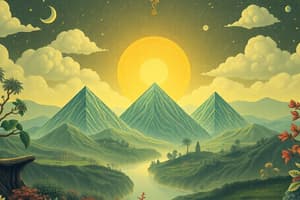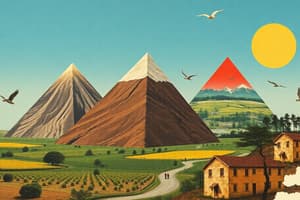Podcast
Questions and Answers
What must the total fertility rate be for a population to be growing?
What must the total fertility rate be for a population to be growing?
- Less than 1.5 children per woman
- Exactly 3.0 children per woman
- At least 2.1 children per woman (correct)
- Between 1.8 and 2.0 children per woman
Which of the following best describes a stateless nation?
Which of the following best describes a stateless nation?
- A group that has their own government but not recognized as a state
- A country with members from multiple nationalities
- A nation that lacks a defined territory and governance (correct)
- An ethnic group that dominates a nation-state
Which organization can be classified as a supranational organization?
Which organization can be classified as a supranational organization?
- An electoral commission
- A local community group
- The United Nations (correct)
- A national government
What is a key characteristic of a presidential democracy?
What is a key characteristic of a presidential democracy?
What are pull factors in migration?
What are pull factors in migration?
Which stages of population pyramids would typically have a declining population?
Which stages of population pyramids would typically have a declining population?
What does GPS stand for and what is its primary function?
What does GPS stand for and what is its primary function?
Which of the following accurately defines cultural diffusion?
Which of the following accurately defines cultural diffusion?
Which resource is classified as inexhaustible?
Which resource is classified as inexhaustible?
What type of economy is characterized by government control and regulation of production?
What type of economy is characterized by government control and regulation of production?
Which of the following best describes mixed economies?
Which of the following best describes mixed economies?
Which of these physical features typically attracts the highest populations?
Which of these physical features typically attracts the highest populations?
What would be an example of secondary economic sector activities?
What would be an example of secondary economic sector activities?
Flashcards
Renewable Resources
Renewable Resources
Resources that can be replenished naturally over a relatively short period of time.
Non-renewable Resources
Non-renewable Resources
Resources that are formed over millions of years and cannot be replenished at a rate comparable to their consumption.
Inexhaustible Resources
Inexhaustible Resources
Resources that are virtually inexhaustible and have an abundant supply for practical purposes.
Population Pyramid
Population Pyramid
Signup and view all the flashcards
Cultural Hearth
Cultural Hearth
Signup and view all the flashcards
Cultural Diffusion
Cultural Diffusion
Signup and view all the flashcards
Latitude
Latitude
Signup and view all the flashcards
Longitude
Longitude
Signup and view all the flashcards
Absolute Monarchy
Absolute Monarchy
Signup and view all the flashcards
Presidential Democracy
Presidential Democracy
Signup and view all the flashcards
Parliamentary Democracy
Parliamentary Democracy
Signup and view all the flashcards
Standard of Living
Standard of Living
Signup and view all the flashcards
Human Development Index (HDI)
Human Development Index (HDI)
Signup and view all the flashcards
Study Notes
Renewable Resources
- Renewable resources can be replenished naturally over a relatively short period.
- Examples include sunlight, wind, water, and biomass.
Non-Renewable Resources
- Non-renewable resources are consumed faster than they can be replenished.
- Examples include fossil fuels (coal, oil, natural gas), minerals, and metals.
Inexhaustible Resources
- Inexhaustible resources are those that are continually available in vast quantities and are not consumed.
- Examples include solar energy, wind energy, hydroelectric power.
Population Pyramids
- Analyze specific details of each country pyramid
- Country A's pyramid is an example of a pyramid that is primarily youthful or developing.
Population Pyramid Stages & Challenges
- Country A - Analysis of the stage, level of development (MDC, NIC, LDC), dependency ratio, challenges.
- Country B - Analysis of the stage, level of development (MDC, NIC, LDC), dependency ratio, challenges.
- Country C - Analysis of the stage, level of development (MDC, NIC, LDC), dependency ratio, challenges.
- Country D - Analysis of the stage, level of development (MDC, NIC, LDC), dependency ratio, challenges.
Growing/Declining Populations
- Growing populations - pyramid shapes that have a wide base (young population increase)
- Declining populations - pyramid shapes that have a narrower base (low birth rates).
Inferences from Population Pyramids
- Population pyramids can reveal demographic trends (e.g., age structure, birth rates, death rates).
- They can also reveal information about a society's economic and social development
- They provide insights into factors such as mortality rates, fertility rates, and migration patterns.
- Demographic characteristics like the percentage of elderly and young people can also be observed.
Cultural Hearth
- Cultural hearths are areas where significant cultural traits develop and spread outwards.
Cultural Diffusion
- Cultural diffusion is the spread of cultural traits, ideas, and beliefs from one culture to another.
- Examples include the spread of food, music, art, and technology and religious practices
Latitude/Parallel Lines
- Latitude lines are imaginary lines that run east-west around the Earth.
- They measure distance north or south of the equator.
Longitude/Meridian Lines
- Longitude lines are imaginary lines that run north-south around the Earth.
- They measure distance east or west of the Prime Meridian.
Map Types
- Political maps show political boundaries.
- Physical maps show landforms and water features.
- Thematic maps focus on one specific topic or theme
Cartograms
- Cartograms are maps that distort the shapes and sizes of geographical areas to represent statistical data
Physical Features and Populations
-
Three physical features often associated with high population density
-
Coastal areas, river valleys, and fertile plains.
GPS
- GPS stands for Global Positioning System.
- It provides location information using satellites.
Rural vs. Urban Life
- Cultural differences between urban and rural areas are significant.
Polytheistic
- Polytheistic religions believe in multiple deities or gods.
- Examples are Hinduism.
Monotheistic
- Monotheistic religions believe in one God.
- Examples are Christianity, Judaism, Islam.
Animistic
- Animistic religions believe that spirits inhabit natural objects (e.g., trees, rocks, rivers).
Enculturation
- Enculturation is the process of acquiring and transmitting knowledge
Religion Information
- A chart (or table) shows specific religions, origins, holy books, founders, etc.
World Religion Distribution
- A map shows the distribution of different religions across the globe.
Latitude and Climate
- Latitude strongly influences climate patterns (based on the angle of incoming solar radiation).
Globalization
- Globalization is the increasing interconnectedness and interdependence of countries through exchange of ideas, goods, and services.
Subsistence Farming
- Subsistence farming is when a farmer grows crops and raises livestock primarily for their own consumption.
Commercial Farming
- Commercial farming is when crops and animals are primarily raised to be sold for profit.
Free Market Economy
- A Free Market Economy is where prices and production of goods and services are decided by the forces of supply and demand
Mixed Economy
- A mixed economy features characteristics of both free and command economies
Command Economy
- A command economy is an economic system where the government controls production and distribution.
Economic Sectors
- Primary: Extracting raw materials—farming, mining, fishing
- Secondary: Manufacturing—transforming raw materials to products—steel mills, car factories
- Tertiary: Providing services—retail, education, healthcare
- Quaternary: Processing information—research, banking, education, consulting
- Quinary: Highest level decision-making—government, top-level research
History of Israel/Palestine
- Summarizes important events and historical context concerning this region
Location A & B
- Identifies locations (A & B) on a map of Southwest Asia, and describes the significance of location B.
Zionism
- Briefly describes Zionism (a national movement supporting the re-establishment of a Jewish homeland in Palestine).
Standard of Living
- Statistical measures to determine standards of living
LDC, NIC, MDC
- Statistical measures to determine development status
Total Fertility Rate
- The TFR is the average number of children born per woman during her reproductive years and important in population growth predictions.
Immigrant/Emigrant/Refugee/Internally Displaced Person
- Definitions and descriptions these terms
Push and Pull Factors
- Identifying factors that drive migration
Formal, Functional, Perceptual Regions
- Defining and examples of each region type
Political Systems
- Definitions and examples of various political systems include monarchy, democracy, dictatorship, and theocracy.
Absolute/Relative Location
- Describing different types of location.
Human-Environment Interaction
- Defines different forms of interaction between humans and their environment.
Egypt's Population
- Description and reason for why majority of Egypt's population is in specific geographic regions.
Nation/State/Stateless Nation
- Defining these terms and examples.
Commodity Dependency
- Describing the concept of a country relying on a single commodity for economic growth or stability.
Brain Drain
- Defining and describing brain drain
Standard of Living/Quality of Life
- Distinguishing and describing these terms
Human Development Index (HDI)
- Defines and states what elements the HDI measures
Cold War
- Brief overview of the Cold War.
Supranational Organization
- Definition and examples of supranational organizations (e.g., UN, NATO).
Total Fertility Rate & Country Development
- Analysis of the correlation between TFR and a nation's level of development
Studying That Suits You
Use AI to generate personalized quizzes and flashcards to suit your learning preferences.




